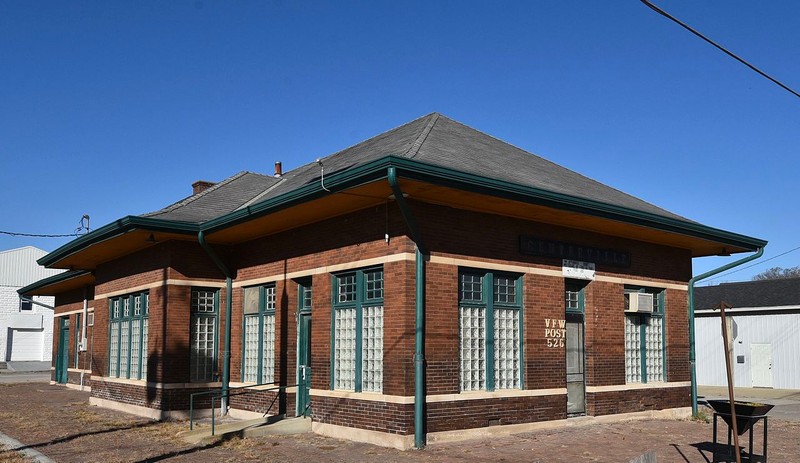Centerville Station
Introduction
Text-to-speech Audio
Centerville Station is a historic train depot built by the Chicago, Burlington & Quincy Railroad (CB&Q) in 1912. It symbolizes the impact railroads had on the development of Centerville and is also significant for its design, which combines elements of the Prairie style and late 19th and early 20th century revival styles. The station is now used as a meeting hall for the local chapter of the Veterans of Foreign Wars.
Images
Now used by the local chapter of the Veterans of Foreign Wars, Centerville Station was built by the Chicago, Burlington & Quincy Railroad in 1912.

Backstory and Context
Text-to-speech Audio
Centerville became the county seat shortly after Appanoose County was established in 1846. The first railroads—the Chicago and Southwestern Railroad (C&S) and the Missouri, Iowa & Nebraska Railroad (MI&N)—arrived in Centerville in 1871. The C&S was actually going to pass through the town of Moulton but Centerville won out after it offered the railroad $125,000 and the right-of-way to build a line through the town. The MI&N was formed by a group consisting of many prominent businessman and professionals from Centerville, who invested a total of around $700,000 for the railroad. The MI&N eventually merged with other railroads to become the Keokuk & Western Railroad, which was later acquired by the CB&Q in 1903.
The railroads spurred economic development in Centerville as they facilitated passenger travel and the export of agricultural and other local products, and transported goods and supplies to local businesses. The community grew as a result and businesses and public buildings were built around the courthouse square. Coal became a major export in the coming decades and by 1911 there were fifth coal mines in the county.
It is not clear when the first train station was built but presumably it was erected around 1871. By the early 1900s, it became clear to the community that a new, larger station was needed. The present station was built in 1912 as a result.
The CB&Q contributed significantly to the county's economy for the next few decades as it employed large number of workers, including 202 in 1930. However, after World War II, railroads began to decline as usage of cars and planes increased. It appears that despite these changes, the CB&Q line to Centerville continued to be used for several decades until 1982 when the company decided abandon it. Unlike many other stations around the country, Centerville Station was not torn down and the VFW purchased it in 1990. It was added to the National Register of Historic Places 2003.
Sources
Naumann, Molly Myers. "CB&Q Passenger Depot." National Register of Historic Places Nomination Form. August 28, 2003. https://npgallery.nps.gov/pdfhost/docs/nrhp/text/03000833.PDF.
Wikimedia Commons: https://commons.wikimedia.org/wiki/File:The_Chicago,_Burlington,_and_Quincy_Railroad_Depot.jpg
